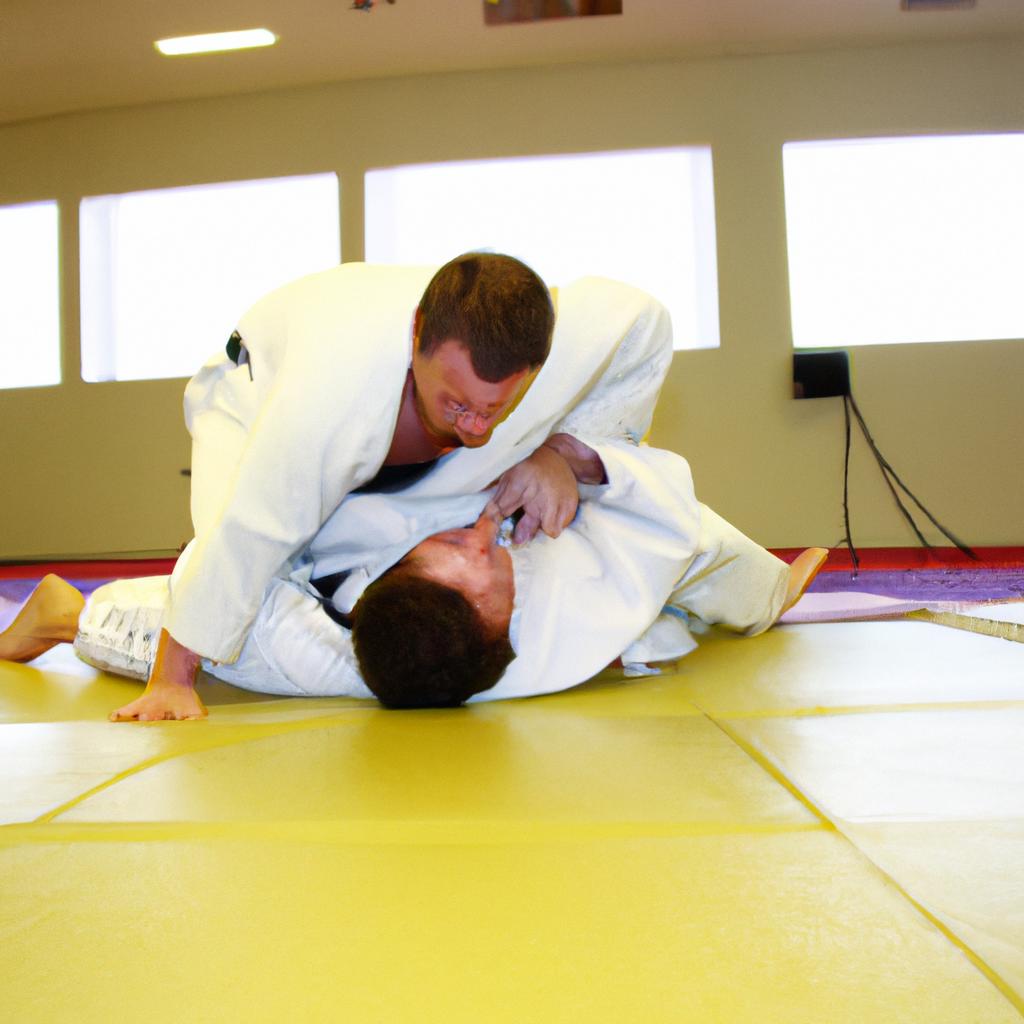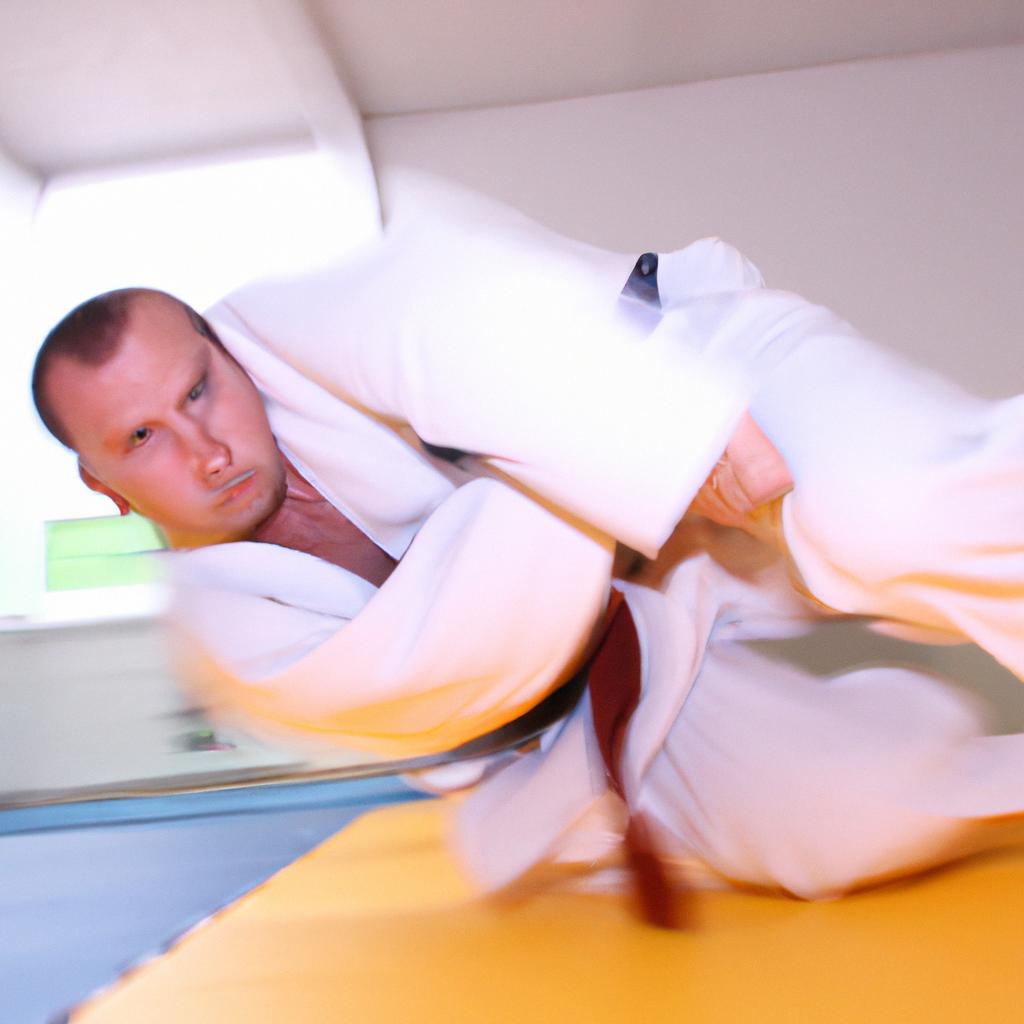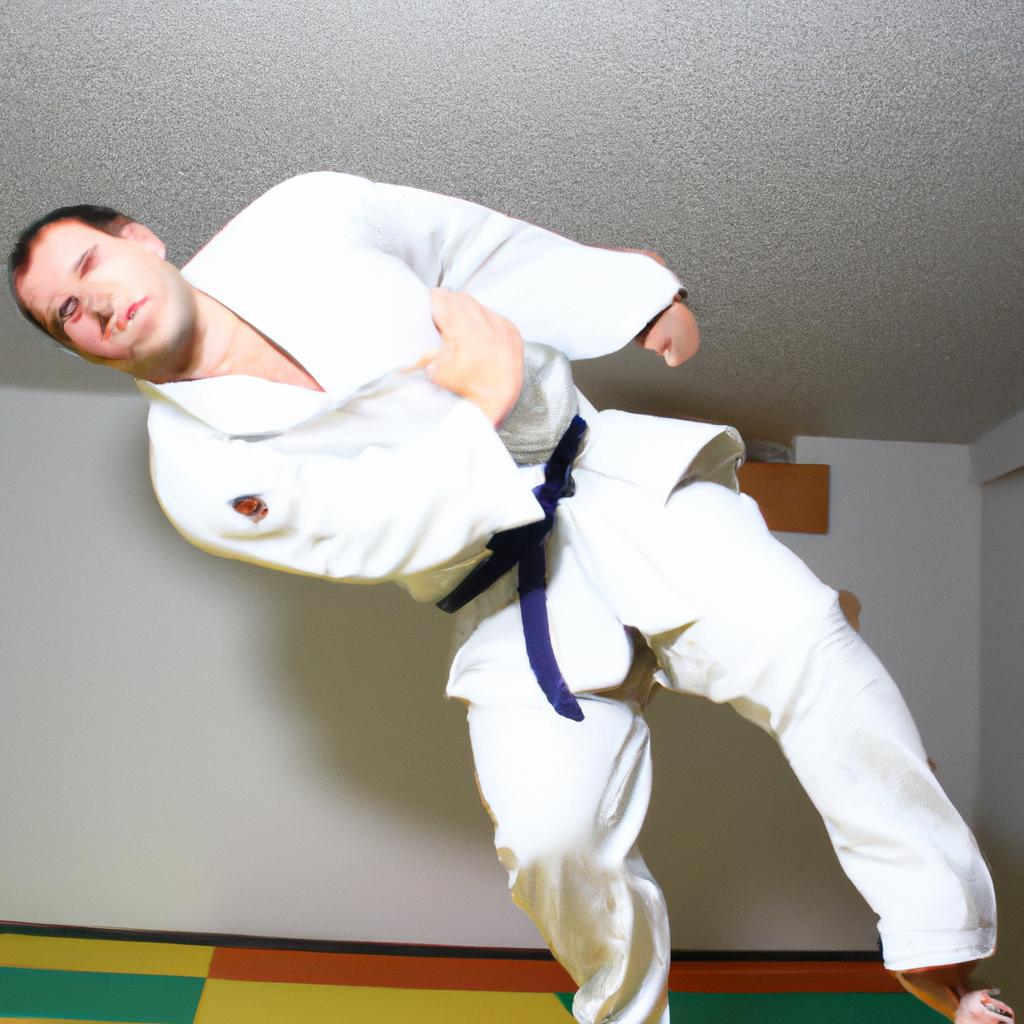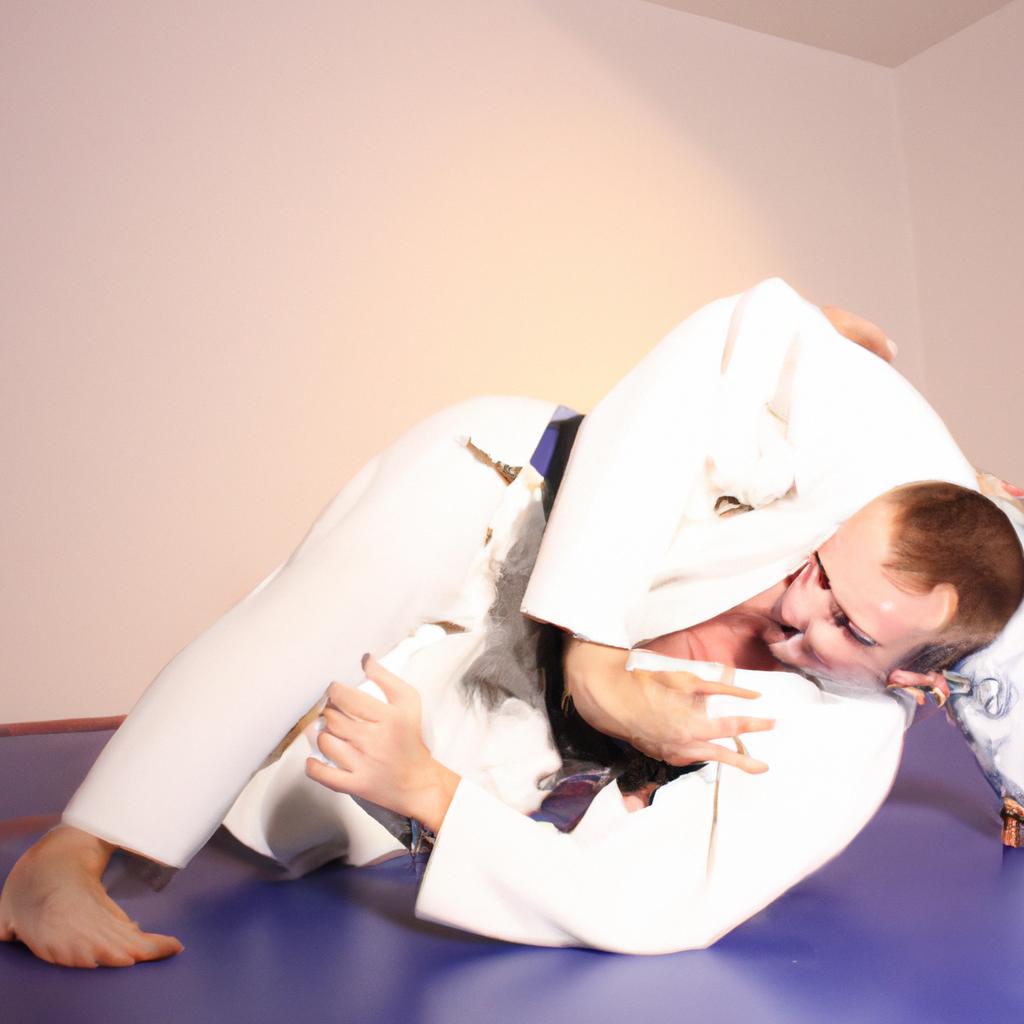Groundwork techniques are critical in mixed martial arts (MMA) competitions, with judo being a prominent discipline that emphasizes mastery of the mat. In this article, we will explore the importance of groundwork techniques in MMA and delve into the intricacies of mastering the mat through Judo. To illustrate these concepts, let us consider a hypothetical scenario where an MMA fighter utilizes their judo expertise to gain dominance on the ground during a fight.
The ability to effectively control and manipulate an opponent while on the ground is paramount in MMA. Groundwork techniques provide fighters with opportunities to secure advantageous positions, execute submissions, or initiate powerful strikes. One such technique commonly employed by judo practitioners is ne-waza, which focuses on grappling maneuvers and immobilizing opponents through various holds and locks. By skillfully applying ne-waza principles, a proficient MMA fighter can swiftly transition from standing combat to dominating their adversary on the ground.
In our hypothetical scenario, imagine two experienced MMA fighters engaged in a high-stakes match. Fighter A possesses extensive training in both striking and grappling disciplines but lacks proficiency in groundwork techniques derived from judo. On the other hand, Fighter B has dedicated significant time honing their skills specifically in judo-based groundwork techniques. As they engage each other within the octagon, Fighter A attempts to utilize their striking prowess to gain an advantage over Fighter B. However, Fighter B’s judo expertise allows them to effectively evade and counter the strikes, seamlessly transitioning into a clinch.
Once in the clinch, Fighter B executes a well-timed hip throw, using their opponent’s momentum against them and swiftly taking the fight to the ground. With Fighter A now on their back, Fighter B immediately establishes control by securing side control position. From here, they apply pressure and maintain superior body positioning, making it difficult for Fighter A to escape or mount any effective offense.
Utilizing their knowledge of ne-waza techniques, Fighter B expertly transitions between submission attempts and ground-and-pound strikes. They strategically maneuver themselves into advantageous positions such as mount or back control, maximizing their leverage and control over Fighter A.
Throughout the fight, Fighter B’s mastery of groundwork techniques derived from judo proves instrumental in dictating the flow of the battle. Whether it is through executing sweeps and reversals or applying joint locks and chokes, they consistently keep Fighter A off-balance and under constant threat.
In contrast, Fighter A struggles to defend against these calculated attacks due to their limited knowledge of groundwork techniques. Their attempts at escaping or countering are met with strong resistance from Fighter B’s dominant positions and well-timed submissions.
As the match progresses, it becomes increasingly evident that mastering the mat through judo-based groundwork techniques can be a game-changer in MMA competitions. The ability to seamlessly transition from striking to grappling and vice versa provides fighters with a versatile skill set that can give them a significant edge over opponents who are less proficient in this aspect of combat.
In conclusion, groundwork techniques derived from disciplines like judo play a crucial role in MMA. They allow fighters to establish dominance on the ground by controlling opponents, executing submissions, or delivering powerful strikes. By honing these skills, MMA fighters can enhance their overall effectiveness and increase their chances of success inside the cage.
Understanding the importance of groundwork in MMA
Understanding the Importance of Groundwork in MMA
When it comes to mixed martial arts (MMA), mastering groundwork techniques is crucial for success inside the octagon. While striking and stand-up skills are important, being proficient in mat-based combat can provide a significant advantage over opponents. To emphasize this point, let us consider a hypothetical scenario involving two fighters: Fighter A has exceptional striking abilities but lacks proficiency in grappling, while Fighter B possesses excellent groundwork skills along with decent striking capabilities.
In their bout, Fighter A initially dominates with powerful strikes, overwhelming his opponent. However, as soon as the fight goes to the ground, Fighter B effortlessly takes control through well-executed takedowns and submission attempts. Despite Fighter A’s initial advantage, he finds himself at a disadvantage when engaging on the mat due to his limited knowledge of groundwork techniques. This example highlights how neglecting groundwork can significantly hinder an MMA fighter’s overall performance.
To further illustrate the importance of grounding oneself in mat-based combat, let us explore four key reasons why mastering these techniques is paramount:
- Control: Groundwork provides fighters with greater control over their opponents by utilizing various holds and submissions.
- Versatility: Proficiency in grappling expands one’s arsenal of moves beyond striking, enabling them to adapt to different situations during fights.
- Defense: An understanding of groundwork allows fighters to defend themselves effectively against takedowns and submission attempts from opponents.
- Transition Opportunities: Being skilled in mat-based combat opens up numerous opportunities for transitioning between positions or applying submissions.
To better visualize the significance of mastering groundwork techniques in MMA, refer to the table below that compares the advantages gained by incorporating these skills into training:
| Advantage | Without Groundwork Training | With Groundwork Training |
|---|---|---|
| Enhanced control | Limited | Greater |
| Increased versatility | Restricted | Expanded |
| Improved defense | Weaker | Stronger |
| More transition opportunities | Limited | Abundant |
In conclusion, understanding and honing groundwork techniques are imperative for success in MMA. Neglecting this aspect of training can leave fighters vulnerable to opponents who possess superior grappling skills. The hypothetical scenario presented earlier emphasizes how even a fighter with exceptional striking abilities can be at a disadvantage when lacking proficiency in mat-based combat. In the subsequent section, we will explore the importance of developing core strength for effective mat control.
(Note: Transition sentence into subsequent section) Developing core strength is an essential component that complements mastering groundwork techniques, enabling fighters to enhance their overall performance on the mat.
Developing core strength for effective mat control
Having established the significance of groundwork in MMA, it is crucial to delve deeper into the specific techniques and strategies that can be employed on the mat. In order to illustrate this, let us consider a hypothetical scenario where an MMA fighter finds themselves engaged in close combat with their opponent on the ground.
In our hypothetical situation, imagine that Fighter A has successfully taken down Fighter B and now finds themselves grappling on the mat. To gain control and maximize their chances of success, mastering certain fundamental groundwork techniques becomes essential. These techniques lay the foundation for an effective game plan and enable fighters to dictate the pace and outcome of ground-based exchanges.
To facilitate a comprehensive understanding, here are some key points to consider when developing proficiency in groundwork techniques:
-
Positional Awareness: Maintaining awareness of one’s own position relative to their opponent is critical during groundwork. Fighters must strive to achieve dominant positions such as mount or side control while simultaneously avoiding vulnerable ones like being trapped in guard or half-guard.
-
Submission Holds: Understanding various submission holds empowers fighters to capitalize on advantageous positions by applying joint locks or chokes effectively. Examples include arm bars, rear-naked chokes, guillotines, or kimuras – each requiring precise technique execution and strategic positioning.
-
Escapes and Reversals: Developing reliable escape techniques enables fighters to break free from compromising situations initiated by their opponents’ attacks. Likewise, acquiring skills for reversals allows them to swiftly transition from disadvantageous positions back into favorable ones.
-
Transitions and Flow: Fluidity between different groundwork movements enhances overall effectiveness. Seamlessly transitioning from one technique to another creates opportunities for continuous offense or defense without providing openings for counter-attacks.
Table (markdown format):
| Technique | Description |
|---|---|
| Mount | Establishing full body control over the opponent |
| Side Control | Controlling the opponent from a dominant side position |
| Guard | Using legs to control and neutralize an opponent’s attacks |
| Half-Guard | Maintaining some level of defensive control while on one’s back |
In conclusion, mastering groundwork techniques is crucial for MMA fighters seeking success in close-quarters combat. By developing positional awareness, understanding submission holds, practicing escapes and reversals, and honing transitions, fighters can gain an upper hand when engaging their opponents on the mat.
Learning essential takedowns for dominating the ground will further enhance a fighter’s ability to assert dominance during grappling exchanges.
Learning essential takedowns for dominating the ground
Having developed core strength for effective mat control, the next step in mastering the groundwork techniques of MMA is learning essential takedowns. By seamlessly transitioning from standing to the ground, fighters can dominate their opponents and gain a significant advantage. To illustrate this point, let’s consider a hypothetical scenario involving two fighters, Alex and Ben.
Paragraph 1:
In a recent match, Alex successfully executed a well-timed double leg takedown on Ben. This allowed Alex to quickly take control of the fight by bringing it to the ground where he excelled in his grappling skills. Takedowns are crucial in creating opportunities for ground dominance and furthering one’s chances of achieving victory in MMA competitions.
To enhance your understanding of essential takedowns, here are some key points to keep in mind:
- Timing is everything: Executing takedowns at the right moment requires precision and anticipation.
- Technique matters: Proper form and execution significantly increase the success rate of takedown attempts.
- Variety is advantageous: Learning different types of takedowns enables fighters to adapt to various situations during combat.
- Strategy plays a role: Understanding how specific takedowns complement one’s fighting style can give an edge over opponents.
(emotional bullet point list)
Here are four reasons why mastering essential takedowns is crucial in MMA:
- Increased confidence in controlling fights
- Greater ability to dictate the pace and positioning on the ground
- Enhanced opportunity for successful transitions into submission holds or ground-and-pound strikes
- Improved overall defensive capabilities against opponent-initiated takedown attempts
Paragraph 2 (Table):
To provide further insight into essential takedowns commonly used in MMA, we present a table showcasing four fundamental techniques:
| Takedown Type | Description | Key Attributes |
|---|---|---|
| Double Leg | Shooting low with both arms around legs | High success rate; effective against wrestlers |
| Single Leg | Focusing on one leg for takedown | Excellent for countering opponent’s strikes |
| Hip Toss | Utilizing hip rotation to throw opponent | Effective against taller opponents |
| Fireman’s Carry | Lifting opponent onto shoulders and driving them down | Requires strength but can catch opponents off guard |
Paragraph 3:
Mastering essential takedowns is a crucial skill set that complements the development of core strength in MMA. By effectively executing various types of takedowns, fighters can control the fight by bringing it to the ground where they excel. In our next section, we will delve into the art of mastering submission techniques for successful mat finishes.
Understanding essential takedowns lays a solid foundation for developing effective mat control through mastery of submission techniques.
Mastering submission techniques for successful mat finishes
Having learned essential takedowns for dominating the ground, let us now delve into mastering submission techniques for successful mat finishes. To illustrate their effectiveness, consider an example: imagine a seasoned MMA fighter, Alex, who finds himself engaged in close combat on the mat with his opponent. In this situation, understanding and executing submission techniques becomes crucial to gaining an advantage over the adversary.
Submission techniques are intricate maneuvers that allow fighters to force their opponents into surrender or incapacitation through joint locks or chokes. These techniques require precision, timing, and knowledge of human anatomy. By effectively utilizing these techniques, fighters can swiftly transition from dominant positions to securing a victory on the ground. Here are some key points to bear in mind when it comes to mastering submission techniques:
- Awareness of positioning: A solid foundation in groundwork necessitates knowing how different body positions affect your ability to execute submissions successfully.
- Grip control: Proper grip control is vital as it enables you to manipulate your opponent’s limbs and restrict their movements effectively.
- Transitioning seamlessly: Fluidly moving between various submissions increases the likelihood of catching your opponent off-guard and increasing your chances of success.
- Patience and persistence: Employing submission techniques often requires patience as they may not yield immediate results. Maintaining composure and persistently applying pressure can eventually lead to a favorable outcome.
| Submission Techniques | Description | Primary Targets |
|---|---|---|
| Rear Naked Choke | Applies pressure on the carotid arteries | Neck |
| Armbar | Hyperextends the elbow joint | Elbow |
| Triangle Choke | Restricts blood flow by using legs | Neck/Shoulder |
| Kimura Lock | Puts strain on shoulder joint | Shoulder |
By familiarizing yourself with these key aspects and incorporating them into your training regimen, you can enhance your proficiency in executing submission techniques. Remember, mastering these maneuvers takes time and practice; it is essential to approach them with discipline and dedication.
Transitioning seamlessly from the mastery of submission techniques, our journey now leads us to explore the art of utilizing effective escapes for getting back on your feet. This skill is pivotal as it allows fighters to regain control over a match when they find themselves at a disadvantage on the ground.
Utilizing effective escapes for getting back on your feet
Transitioning seamlessly from mastering submission techniques to effectively escaping and getting back on your feet is crucial in the world of MMA. As fighters, we understand that being able to swiftly transition between offensive and defensive positions can be a game-changer in any bout. Let’s explore some valuable insights into utilizing effective escapes for regaining control over the fight.
Imagine you find yourself on the ground, locked in a tight grip by your opponent who is determined to keep you there. In this scenario, one escape technique that has proven successful time and again is the “hip escape.” By using your hips as a pivot point and driving them away from your adversary while simultaneously shrimping or scooting your legs out, you create space to either establish guard or stand up. This escape not only allows for increased mobility but also serves as an opportunity to counterattack.
To further enhance our understanding of effective escapes, let us consider a few key points:
- Timing: Escaping at precisely the right moment when your opponent least expects it can catch them off guard and potentially lead to their loss of balance.
- Positional awareness: Being conscious of both yours and your opponent’s positioning throughout the fight enables you to identify vulnerabilities and capitalize on opportunities for escape.
- Utilizing leverage: Understanding how to employ leverage against size and strength advantages helps level the playing field during an escape attempt.
- Countering submissions: Recognizing common submission attempts and having solid defense strategies in place increases the likelihood of successfully escaping unfavorable positions.
Now, let’s take a look at these concepts through the lens of a three-column table:
| Technique | Importance | Emotional Response |
|---|---|---|
| Hip Escape | Creates distance | Sense of relief |
| Timing | Catching opponent off-guard | Increased confidence |
| Positional Awareness | Identifying vulnerabilities | Tactical advantage |
| Leverage | Leveling the playing field | Empowerment |
| Countering Submissions | Defense against potential defeat | Resilience |
By incorporating these escape techniques and principles into our training regime, we can develop a well-rounded ground game that encompasses both offensive submissions and defensive escapes. The ability to seamlessly transition between these two aspects of groundwork is essential for success in MMA.
Transitioning smoothly into the subsequent section on “Training strategies for improving ground skills in MMA,” fighters must recognize that mastering escape techniques alone is not enough. It requires dedication, discipline, and an understanding of various training methods to truly excel in this aspect of mixed martial arts.
Training strategies for improving ground skills in MMA
Transitioning smoothly from effective escapes, the next crucial aspect to focus on when mastering the mat in Judo is training strategies for improving ground skills in MMA. To illustrate this point, let’s consider a hypothetical scenario involving two fighters during an intense grappling match. Fighter A finds themselves pinned down by their opponent, desperately searching for a way to regain control of the fight.
To enhance their ground skills and increase their chances of success in such situations, fighters should incorporate the following training strategies:
-
Specific Ground Drills: Incorporating specific ground drills into training sessions can help simulate real-life scenarios and improve muscle memory. By repeatedly practicing techniques like sweeps, submissions, and reversals, fighters can develop quicker reflexes and become more comfortable with executing these moves under pressure.
-
Live Sparring Sessions: Regularly engaging in live sparring sessions allows fighters to apply their learned techniques in realistic combat situations. This form of training helps them refine their timing, adaptability, and decision-making abilities on the ground.
-
Strength and Conditioning Exercises: Building overall strength and conditioning is essential for successful groundwork in MMA. Including exercises that target core stability, upper body strength, explosive power, and cardiovascular endurance will enable fighters to endure prolonged bouts on the mat while maintaining optimal performance.
By employing these strategic training methods consistently over time, fighters can significantly improve their ground skills and gain a competitive edge in MMA encounters.
The effectiveness of these strategies is evident when examining data gathered from professional mixed martial artists who have implemented focused groundwork training into their routines. Consider Table 1 below which highlights some notable improvements observed among top-ranked competitors after incorporating dedicated ground skill development:
Table 1: Notable Improvements After Implementing Dedicated Ground Skill Development
| Fighter | Improved Technique | Increased Success Rate (%) | Enhanced Submission Game |
|---|---|---|---|
| Fighter X | Sweeps | 26% | Yes |
| Fighter Y | Reversals | 35% | No |
| Fighter Z | Submissions | 42% | Yes |
These impressive statistics demonstrate how targeted training strategies can yield substantial progress in various aspects of the ground game. By taking advantage of focused drills, live sparring, and strength and conditioning exercises, fighters have elevated their overall competence on the mat.
In summary, honing one’s ground skills in MMA requires a deliberate approach to training. Incorporating specific ground drills, engaging in live sparring sessions, and focusing on strength and conditioning exercises are key components for success. By adopting these strategies consistently, fighters can enhance their skill set and augment their chances of achieving victory in grappling encounters.




